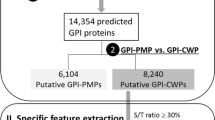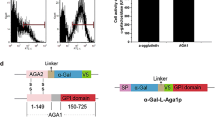Abstract
The expression of functional proteins on the cell surface using glycosylphosphatidylinositol (GPI)-anchoring technology is a promising approach for constructing yeast cells with special functions. The functionality of surface-engineered yeast strains strongly depends on the amount of functional proteins displayed on their cell surface. On the other hand, since the yeast cell wall space is finite, heterologous protein carrying capacity of the cell wall is limited. Here, we report the effect of CCW12 and CCW14 knockout, which encode major nonenzymatic GPI-anchored cell wall proteins (GPI-CWPs) involved in the cell wall organization, on the heterologous protein carrying capacity of yeast cell wall. Aspergillus aculeatus β-glucosidase (BGL) was used as a reporter to evaluate the protein carrying capacity in Saccharomyces cerevisiae. No significant difference in the amount of cell wall–associated BGL and cell-surface BGL activity was observed between CCW12 and CCW14 knockout strains and their control strain. In contrast, in the CCW12 and CCW14 co-knockout strains, the amount of cell wall–associated BGL and its activity were approximately 1.4-fold higher than those of the control strain and CCW12 or CCW14 knockout strains. Electron microscopic observation revealed that the total cell wall thickness of the CCW12 and CCW14 co-knockout strains was increased compared to the parental strain, suggesting a potential increase in heterologous protein carrying capacity of the cell wall. These results indicate that the CCW12 and CCW14 co-knockout strains are a promising host for the construction of highly functional recombinant yeast strains using cell-surface display technology.
Key points
• CCW12 and/or CCW14 of a BGL-displaying S. cerevisiae strain were knocked out.
• CCW12 and CCW14 co-disruption improved the display efficiency of BGL.
• The thickness of the yeast cell wall was increased upon CCW12 and CCW14 knockout.
Graphical abstract




Similar content being viewed by others
Data availability
All relevant data generated during this study are included in the article and its supplementary information file.
References
Angelini A, Chen TF, de Picciotto S, Yang NJ, Tzeng A, Santos MS, Van Deventer JA, Traxlmayr MW, Wittrup KD (2015) Protein engineering and selection using yeast surface display. Methods Mol Biol 1319:3–36. https://doi.org/10.1007/978-1-4939-2748-7_1
Arroyo J, Farkaš V, Sanz AB, Cabib E (2016) Strengthening the fungal cell wall through chitin-glucan cross-links: effects on morphogenesis and cell integrity. Cell Microbiol 18(9):1239–1250. https://doi.org/10.1111/cmi.12615
Bamba T, Inokuma K, Hasunuma T, Kondo A (2018) Enhanced cell-surface display of a heterologous protein using SED1 anchoring system in SED1-disrupted Saccharomyces cerevisiae strain. J Biosci Bioeng 125(3):306–310. https://doi.org/10.1016/j.jbiosc.2017.09.013
Chen DC, Yang BC, Kuo TT (1992) One-step transformation of yeast in stationary phase. Curr Genet 21(1):83–84. https://doi.org/10.1007/BF00318659
Grzeschik J, Hinz SC, Könning D, Pirzer T, Becker S, Zielonka S, Kolmar H (2017) A simplified procedure for antibody engineering by yeast surface display: coupling display levels and target binding by ribosomal skip**. Biotechnol J 12(2). https://doi.org/10.1002/biot.201600454
Inokuma K, Hasunuma T, Kondo A (2014) Efficient yeast cell-surface display of exo- and endo-cellulase using the SED1 anchoring region and its original promoter. Biotechnol Biofuels 7(1):8. https://doi.org/10.1186/1754-6834-7-8
Inokuma K, Yoshida T, Ishii J, Hasunuma T, Kondo A (2015) Efficient co-displaying and artificial ratio control of α-amylase and glucoamylase on the yeast cell surface by using combinations of different anchoring domains. Appl Microbiol Biotechnol 99(4):1655–1663. https://doi.org/10.1007/s00253-014-6250-1
Inokuma K, Bamba T, Ishii J, Ito Y, Hasunuma T, Kondo A (2016) Enhanced cell-surface display and secretory production of cellulolytic enzymes with Saccharomyces cerevisiae Sed1 signal peptide. Biotechnol Bioeng 113(11):2358–2366. https://doi.org/10.1002/bit.26008
Inokuma K, Hasunuma T, Kondo A (2018) Whole cell biocatalysts using enzymes displayed on yeast cell surface. In: Chang H (ed) Emerging Areas in Bioengineering. Wiley-VCH, New York, pp 81–92
Inokuma K, Kurono H, den Haan R, van Zyl WH, Hasunuma T, Kondo A (2020) Novel strategy for anchorage position control of GPI-attached proteins in the yeast cell wall using different GPI-anchoring domains. Metab Eng 57:110–117. https://doi.org/10.1016/j.ymben.2019.11.004
Ishii J, Izawa K, Matsumura S, Wakamura K, Tanino T, Tanaka T, Ogino C, Fukuda H, Kondo A (2009) A simple and immediate method for simultaneously evaluating expression level and plasmid maintenance in yeast. J Biochem 145(6):701–708. https://doi.org/10.1093/jb/mvp028
Ito Y, Kitagawa T, Yamanishi M, Katahira S, Izawa S, Irie K, Furutani-Seiki M, Matsuyama T (2016) Enhancement of protein production via the strong DIT1 terminator and two RNA-binding proteins in Saccharomyces cerevisiae. Sci Rep 6:36997. https://doi.org/10.1038/srep36997
Jakočiūnas T, Bonde I, Herrgård M, Harrison SJ, Kristensen M, Pedersen LE, Jensen MK, Keasling JD (2015) Multiplex metabolic pathway engineering using CRISPR/Cas9 in Saccharomyces cerevisiae. Metab Eng 28:213–222. https://doi.org/10.1016/j.ymben.2015.01.008
Katahira S, Mizuike A, Fukuda H, Kondo A (2006) Ethanol fermentation from lignocellulosic hydrolysate by a recombinant xylose- and cellooligosaccharide-assimilating yeast strain. Appl Microbiol Biotechnol 72:1136–1143. https://doi.org/10.1007/s00253-006-0402-x
Klis FM (1994) Review: cell wall assembly in yeast. Yeast 10(7):851–869. https://doi.org/10.1002/yea.320100702
Lei H, ** S, Karlsson E, Schultz-Cherry S, Ye K (2016) Yeast surface-displayed H5N1 avian Influenza vaccines. J Immunol Res 2016:4131324–4131312. https://doi.org/10.1155/2016/4131324
Lei H, **e B, Gao T, Cen Q, Ren Y (2020) Yeast display platform technology to prepare oral vaccine against lethal H7N9 virus challenge in mice. Microb Cell Factories 19(1):53. https://doi.org/10.1186/s12934-020-01316-1
Lesage G, Bussey H (2006) Cell wall assembly in Saccharomyces cerevisiae. Microbiol Mol Biol Rev : MMBR 70(2):317–343. https://doi.org/10.1128/MMBR.00038-05
Li B, Scarselli M, Knudsen CD, Kim SK, Jacobson KA, McMillin SM, Wess J (2007) Rapid identification of functionally critical amino acids in a G protein-coupled receptor. Nat Methods 4(2):169–174. https://doi.org/10.1038/nmeth990
Lian J, Schultz C, Cao M, HamediRad M, Zhao H (2019) Multi-functional genome-wide CRISPR system for high throughput genotype-phenotype map**. Nat Commun 10(1):5794. https://doi.org/10.1038/s41467-019-13621-4
Liu Z, Ho SH, Sasaki K, den Haan R, Inokuma K, Ogino C, van Zyl WH, Hasunuma T, Kondo A (2016) Engineering of a novel cellulose-adherent cellulolytic Saccharomyces cerevisiae for cellulosic biofuel production. Sci Rep 6:24550. https://doi.org/10.1038/srep24550
Liu Z, Inokuma K, Ho SH, den Haan R, van Zyl WH, Hasunuma T, Kondo A (2017) Improvement of ethanol production from crystalline cellulose via optimizing cellulase ratios in cellulolytic Saccharomyces cerevisiae. Biotechnol Bioeng 114(6):1201–1207. https://doi.org/10.1002/bit.26252
Lu CF, Kurjan J, Lipke PN (1994) A pathway for cell-wall anchorage of Saccharomyces cerevisiae alpha-agglutinin. Mol Cell Biol 14(7):4825–4833. https://doi.org/10.1128/mcb.14.7.4825
Moreno-García J, Coi AL, Zara G, García-Martínez T, Mauricio JC, Budroni M (2018) Study of the role of the covalently linked cell wall protein (Ccw14p) and yeast glycoprotein (Ygp1p) within biofilm formation in a flor yeast strain. FEMS Yeast Res 18(2). https://doi.org/10.1093/femsyr/foy005
Moukadiri I, Armero J, Abad A, Sentandreu R, Zueco J (1997) Identification of a mannoprotein present in the inner layer of the cell wall of Saccharomyces cerevisiae. J Bacteriol 179(7):2154–2162. https://doi.org/10.1128/jb.179.7.2154-2162.1997
Mrsa V, Ecker M, Strahl-Bolsinger S, Nimtz M, Lehle L, Tanner W (1999) Deletion of new covalently linked cell wall glycoproteins alters the electrophoretic mobility of phosphorylated wall components of Saccharomyces cerevisiae. J Bacteriol 181(10):3076–3086. https://doi.org/10.1128/JB.181.10.3076-3086.1999
Nambu-Nishida Y, Nishida K, Hasunuma T, Kondo A (2017) Development of a comprehensive set of tools for genome engineering in a cold- and thermo-tolerant Kluyveromyces marxianus yeast strain. Sci Rep 7(1):8993. https://doi.org/10.1038/s41598-017-08356-5
Ragni E, Sipiczki M, Strahl S (2007) Characterization of Ccw12p, a major key player in cell wall stability of Saccharomyces cerevisiae. Yeast 24(4):309–319. https://doi.org/10.1002/yea.1465
Ragni E, Piberger H, Neupert C, García-Cantalejo J, Popolo L, Arroyo J, Aebi M, Strahl S (2011) The genetic interaction network of CCW12, a Saccharomyces cerevisiae gene required for cell wall integrity during budding and formation of mating projections. BMC Genomics 12:107. https://doi.org/10.1186/1471-2164-12-107
Shankarnarayan S, Malone CL, Deschenes RJ, Fassler JS (2008) Modulation of yeast Sln1 kinase activity by the CCW12 cell wall protein. J Biol Chem 283(4):1962–1973. https://doi.org/10.1074/jbc.M706877200
Shibasaki S, Ueda M, Ye K, Shimizu K, Kamasawa N, Osumi M, Tanaka A (2001) Creation of cell surface-engineered yeast that display different fluorescent proteins in response to the glucose concentration. Appl Microbiol Biotechnol 57(4):528–533. https://doi.org/10.1007/s002530100767
Shibasaki S, Kawabata A, Tanino T, Kondo A, Ueda M, Tanaka M (2009) Evaluation of the biodegradability of polyurethane and its derivatives by using lipase-displaying arming yeast. Biocontrol Sci 14(4):171–175. https://doi.org/10.4265/bio.14.171
Shusta EV, Kieke MC, Parke E, Kranz DM, Wittrup KD (1999) Yeast polypeptide fusion surface display levels predict thermal stability and soluble secretion efficiency. J Mol Biol 292(5):949–956. https://doi.org/10.1006/jmbi.1999.3130
van der Vaart JM, te Biesebeke R, Chapman JW, Toschka HY, Klis FM, Verrips CT (1997) Comparison of cell wall proteins of Saccharomyces cerevisiae as anchors for cell surface expression of heterologous proteins. Appl Environ Microbiol 63(2):615–620. https://doi.org/10.1128/aem.63.2.615-620.1997
Wang H, Lang Q, Li L, Liang B, Tang X, Kong L, Mascini M, Liu A (2013) Yeast surface displaying glucose oxidase as whole-cell biocatalyst: construction, characterization, and its electrochemical glucose sensing application. Anal Chem 85(12):6107–6112. https://doi.org/10.1021/ac400979r
Wentz AE, Shusta EV (2007) A novel high-throughput screen reveals yeast genes that increase secretion of heterologous proteins. Appl Environ Microbiol 73(4):1189–1198. https://doi.org/10.1128/AEM.02427-06
Yamakawa S, Yamada R, Tanaka T, Ogino C, Kondo A (2012) Repeated fermentation from raw starch using Saccharomyces cerevisiae displaying both glucoamylase and α-amylase. Enzym Microb Technol 50(6-7):343–347. https://doi.org/10.1016/j.enzmictec.2012.03.005
Zhao SX, Guo YH, Wang QN, Luo HL, He CZ, An B (2020) Expression of flagellin at yeast surface increases biocontrol efficiency of yeast cells against postharvest disease of tomato caused by Botrytis cinerea. Postharvest Biol Technol 162:111112. https://doi.org/10.1016/j.postharvbio.2019.111112
Code availability
Not applicable.
Funding
This work was supported in part by Japan Society for the Promotion of Science (JSPS) KAKENHI Grant Number JP18K05554, and JSPS and National Research Foundation (NRF) of South Africa under the JSPS-NRF Joint Research Program (JSPS Grant Number JPJSBP120196503 and NRF Grant Number 118894).
Author information
Authors and Affiliations
Contributions
KI designed the research and wrote the manuscript. TB designed the experiments. KI, TB, Y Kitada, and Y Kobayashi, TY performed the experiments. RDH, WHVZ, AK, and TH revised the manuscript. AK and TH conceived and supervised the research. All authors read and approved the manuscript.
Corresponding author
Ethics declarations
Ethics approval
Not applicable.
Consent to participate
Not applicable.
Consent for publication
The authors approved the manuscript submission to Applied Microbiology and Biotechnology.
Conflict of interest
The authors declare no competing interests.
Additional information
Publisher’s note
Springer Nature remains neutral with regard to jurisdictional claims in published maps and institutional affiliations.
Supplementary information
ESM. 1
(PDF 403 kb)
Rights and permissions
About this article
Cite this article
Inokuma, K., Kitada, Y., Bamba, T. et al. Improving the functionality of surface-engineered yeast cells by altering the cell wall morphology of the host strain. Appl Microbiol Biotechnol 105, 5895–5904 (2021). https://doi.org/10.1007/s00253-021-11440-6
Received:
Revised:
Accepted:
Published:
Issue Date:
DOI: https://doi.org/10.1007/s00253-021-11440-6




